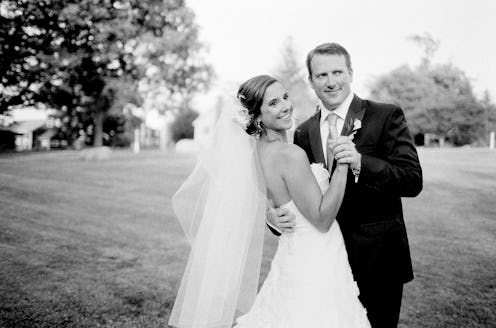
We all know what a “traditional” wedding looks like — but as it turns out, this vision of a bride in white and an expensive ceremony and reception might not actually be all that “traditional” after all. In a piece for Aeon, Beth Montemurro traces how wedding traditions have evolved over the years — and interestingly, she found that the trappings we view today as the elements of a traditional wedding haven’t always been the norm. In some cases, they’re actually even quite recent in terms of their trendiness. It just goes to show how quickly things fall in and out of style, doesn’t it?
The real takeaway, I feel, is this: Just do you. If that’s “traditional,” awesome; and if it’s not, that’s also awesome. The point Montemurro ultimately arrives at is that weddings have become not only a way to celebrate the union of two families, or of two people, or even sharing a momentous occasion with the important people in your life; it’s about self-expression. Find what works for you and your partner, and go for it.
The whole piece is well worth a read, so head on over to Aeon to check it out; in the meantime, here are five wedding traditions that aren’t actually traditional, according to Montemurro:
1. The Expensive Price Tag
For centuries, lavish wedding ceremonies and huge receptions were only held by the well-off; few could actually afford them. Most people just put on their best dresses or suits, said their “I dos,” and had a small party at home.
2. The White Dress
Although it’s long been said that wearing white at a wedding is supposed to reflect the bride’s “purity,” wedding gowns haven’t always been the color of snow or ivory. In 1840, Queen Victoria chose to wear white satin at her wedding; it proved to be the beginning of a trend as first the wealthy elite took to the idea, later followed by the masses.
3. The Diamond Engagement Ring
We’ve already been over this one a few times, but in case you need a refresher, here it is: In the ’30s, DeBeers (which, by the way, is a cartel, not just a jewelry store) created the idea of the diamond engagement ring for an ad campaign. A diamond isn’t forever; the trend is only about 80 years old. Check out The Atlantic’s excellent 1982 article “Have You Ever Tried to Sell a Diamond?” for more.
4. Eloping
These days, “eloping” has evolved to mean something very different than it once did; as Montemurro puts it, the term “now means marrying alone rather than surreptitiously.” Rather than running off to marry in secret, these days, companies help couples plan for elopement, with photographs showing gowns, styled hair and makeup, tuxedos, and more elements usually associated with “traditional” weddings (Montemurro cites Yosemite weddings as an example). Eloping isn’t about secrecy; it’s about privacy, intimacy, and having a wedding without the crowds of hundreds today’s standard weddings often draw.
5. What Weddings Are “Supposed to Look Like”
Montemurro points to sociologist Chrys Ingraham’s 1999 book White Weddings: Romancing Heterosexuality in Popular Culture to examine an interesting phenomenon: A lot of what we now consider “traditional” in weddings has in recent years become institutionalized in large part due to pop culture. Films, commercials, and television shows — particular U.S. reality TV series — constantly show us what weddings are “supposed to look like.” Writes Montemurro, “The more these wedding standards appeared in popular culture, the more they became institutionalized.” Huh.
Head on over to Aeon for more.
Images: MandyMayberry/Flickr; Giphy (4); Jei the Peter Pan/Tumblr